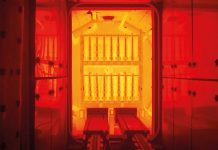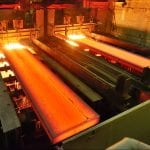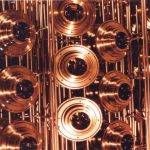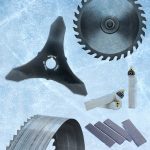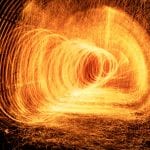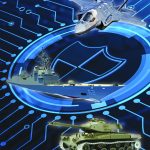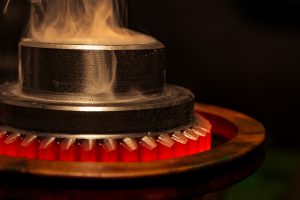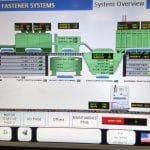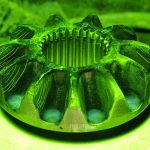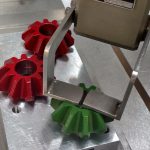The American Gear Manufacturers Association’s (AGMA) Emerging Technologies Committee (ETC) recently organized a show floor tour of the Rapid + TCT Exhibition (Rapid). The ETC’s 3D Printing Sub-Committee (3DPC) has been monitoring the developments in the additive manufacturing (AM) industry for several years, providing AGMA members with distilled industry updates via webinars, white papers, and other news updates. The 3DPC previously arranged a tour of Rapid in 2019 where members visited booths of a wide range of AM companies including machine OEMs, materials designers, independent printing shops, and post-processing suppliers. The conclusion at the time was that polymer/plastic AM for tooling, jigs, and fixtures was an established application with strong potential to aid gear manufacturers, gear users, and adjacent gear manufacturing suppliers. However, metal AM had limited traction relative to gears at the time, for several reasons:
• Standard gear alloy availability for AM was limited (despite general availability for non-AM powder metal applications).
• Printing resolution limitations dictated that any precision gear applications would require subsequent machining steps.
• Printing costs were considerably higher than traditional manufacturing methods excluding special-case, small lot batches.
• Printing quality ranging from parameter optimization, to in-process monitoring, and even post-print inspection was an additional challenge creating more costs/hurdles for gear application adoption.
As a result, the 3DPC and the ETC determined that AM should continue to be watched, but was not likely to have a significant impact on AGMA members’ business in the near term.
However, as a fast-moving and developing industry, much has changed in AM in recent years. Thus, the 3DPC organized another Rapid tour this year. Mary Ellen Doran, AGMA director, Emerging Technology, arranged for members of the 3DPC to visit a range of AM and AM-related companies, including: 3DEO, Desktop Metal, SPEE3D, JEOL, DM3D Technology LLC, Nidec Machine Tool, Hoganas, AddUp, MELD Manufacturing, QuesTek Innovations, FormAlloy, RPM Innovations, and REM Surface Engineering. The committee wanted to focus heavily on two areas — large-format metal AM technologies and binder jetting — while also visiting with new industry entrants and relevant adjacent suppliers such as powder manufacturers, material designers, and surface finishing technology providers.
‘Of-interest’ tech
Large format metal AM technologies such as directed energy deposition (DED), cold spray, and friction stir welding were deemed “of interest” to the committee due to their potential to serve in a repair capacity for large-scale gearing. Sourcing replacement components for any low-volume application is very difficult. Large-scale gearing fits this mold and has the additional challenge of being (typically) very expensive given the obvious material demands and limited supplier options. Thus, a potential gear repair option for significantly damaged large gears where material addition would be required would be of interest.
Binder jetting, on the other end of the spectrum, has been known as the “fastest” and “lowest cost” metal AM technology for some time. However, prior reviews of the technology have not shown significant use in the gear industry due to some known challenges relative to the required sintering operations as well as reduced material properties as compared to wrought/forged materials. Therefore, the committee was interested to understand what developments and/or maturation had occurred relative to binder jetting.
Lastly, it was determined by the committee prior to attendance that L-PBF technology remained unlikely to significantly impact AGMA members outside of specialty cases; thus, AddUp was the only L-PBF machine manufacturer visited as they were not visited on the previous (2019) tour and they also offer laser blown powder directed energy deposition (LBP-DED) machines.
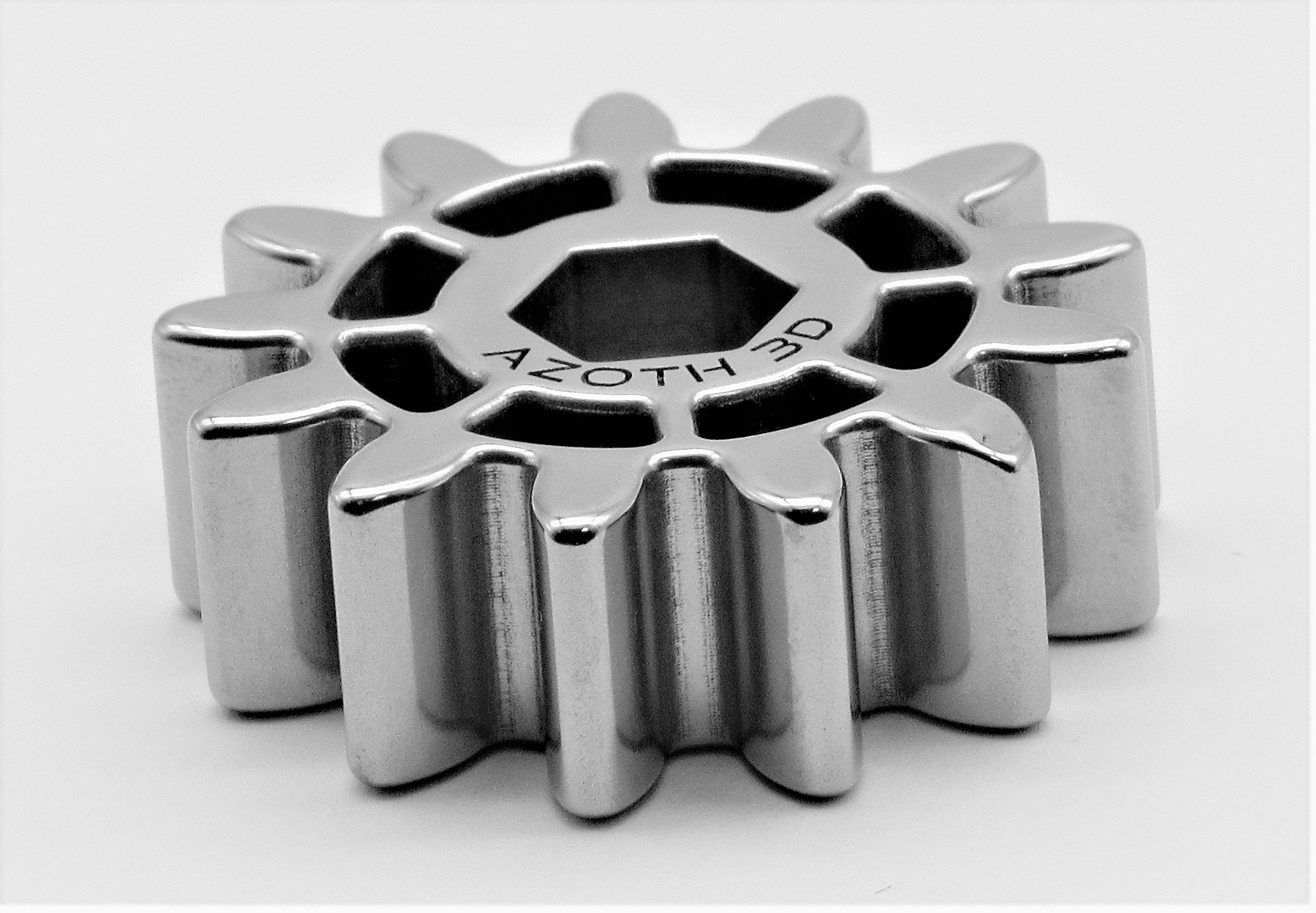
High-volume applications
The 3DPC started the tour with binder jetting/binder jet-like companies 3DEO and Desktop Metal. Both companies were a part of the 2019 tour, and thus provided interesting insight into the rate of change/advancement in metal AM. Committee members learned of advances made by both of these companies to increase productivity, part quality, and alloy range — all features that contributed to the 3DPC’s prior conclusions that AM was not “ready” to strongly impact gear manufacturing. 3DEO’s commitment to serial production as both a machine maker (although not currently a machine seller) and a user of the technology provided a strong perspective on the potential to use AM for high-volume applications. Desktop Metal’s newer machine offerings, the Shop System™ and Production System™, boast industry-leading deposition rates and offer flexibility to users based on their build-bed volume, which allows for multi-part batches and nesting. In both cases, part size is still a limiting factor due to sintering challenges that exist with larger parts; it should be noted that this challenge is present for essentially any binder jetting applications and is not limited to 3DEO/Desktop Metal. However, in both cases, potential gear materials exist, and for non-high speed/high load applications with medium- to high-volume demand, binder jetting is a valid forming technology to consider. Given the inherently lower density of binder jetting, it is not likely to be a preferred option for most high load gear applications, but there certainly are MIM and similar powdered metal gears where binder jetting should see application growth in the coming years.
SPEE3D was the tour’s next stop. SPEE3D is a relatively new entrant into the additive manufacturing industry. They use cold spray technology rather than sintering or melt-based forming techniques. Cold spray was invented in the 1980s and has been used for repair and coating applications for some time. It functions by shooting metal particles onto a surface at supersonic speeds in order to create a metallurgical bond. The technology is interesting, in part because the bonding process does not require heat or create heat-affected zones (as would be produced by welding operations). Recent developments (many SPEE3D) have brought cold spray to market as a part fabrications technique, using a multi-axis robotic deposition nozzle and a rotating, multi-axis build plate. In addition to being a non-thermal/melt-based forming process, cold spray is exceptionally fast. The 3DPC was able to watch a part being built in its entirety during the roughly 10 minutes that we were at SPEE3D’s both. The drawbacks of cold spray are that it tends to be more effective/viable with softer metals such as aluminum and copper alloys, and it is generally not as dense as L-PBF, EBM, or traditionally machined components. SPEE3D does, however, list some hardenable stainless steels within their material capabilities. And, taking its deposition speed advantages into consideration, it is a technology worth considering for large, specialty gear repair operations where a tooth (or teeth) needs to be rebuilt and/or in the event a gear blank cannot be obtained quickly enough to address an immediate production downtime event. Subsequent machining operations would be required to eliminate the fairly pronounced layer lines present on cold spray components. As a result, outside of non-standard situations, cold spray is not likely to have a major impact on the gear-manufacturing industry in the near future without additional steel materials being available.

Electron beam melting
JEOL USA/Ltd. was the tour’s next stop. JEOL is the first “industrial-focused” electron beam melting (EBM) machine supplier to enter the market since Arcam AB — now a part of GE Additive. The EBM process differs from the L-PBF process in a number of ways, including its powder/melting source (electron beams), its build atmosphere (heated vacuum), and its standard powder size (large than L-PBF). Outside of some very notable, large-scale aero-engine applications (the GE9X’s lower pressure turbine blades), EBM has noticeably lagged behind L-PBF in its industry adoption. The 3DPC wanted to visit JEOL and understand what their machine may bring to the table as compared to existing EBM equipment as well as well-known L-PBF equipment. While EBM is certainly a good technology for many potential applications, its build time (as with L-PBF) limits its potential gear applications, and the alloy capabilities (primarily limited to titanium and nickel-chrome alloys) are largely not applicable to the gear industry. The 3DPC did not find any major differences or advancements with the JEOL EBM machine that would sway the pre-existing conclusion that neither L-PBF nor EBM are likely to have significant impact on the gear-manufacturing industry, but it is good to see growth of machine supply in the EBM space. Further, if JEOL is able to increase EBM use and establish broader availability of gear steels, especially high heat resistant/high strength specialty steels such as Ferrium® C64 or Pyrowear® 53, then it may become a more interesting technology for high-strength gear applications.
An additional tour stop was MELD Manufacturing. MELD, like JEOL, is a new entrant to the AM market. They are industrializing friction stir welding as an additive manufacturing process. Friction stir welding is a solid-state joining/deposition process that functions by rapidly rotating a tool which deposits a material onto a specified surface. The friction-generated heat causes the material being deposited to rapidly melt (and subsequently cool) allowing for the joining of dissimilar materials, the addition of new part features on already fabricated components, and the building of wholly new components. As the process uses bar stock, it theoretically has an extremely wide range of material options, including gear steels. However, gear steels were not listed in MELD’s material capabilities, nor were they currently a focus for the company. As with cold spray, while there is obvious potential for friction stir welding to be applied to large gear tooth repair and/or large gear blank/near net shape component fabrication, the technology does not appear ready to impact the gear-manufacturing industry strongly at the moment.
Based on the 3DPC’s interest in DED, a number of suppliers were visited on the tour including AddUp, DM3D, FormAlloy, Nidec Machine Tool, and RPM Innovations. The 3DPC was primarily interested in understanding these companies’ capabilities for their laser blown powder DED (LBP-DED) equipment as this technology offers considerably higher part resolution as compared to wire-based DED. Similar to cold spray and friction stir welding, LBP-DED can be used as a repair (i.e. component feature rebuilding) process or as a new component forming process. Recent developments with LBP-DED relative to the fabrication of large-scale rocket nozzles and member experience regarding the advancement/improvement of deposition accuracy and surface finish drove the 3DPC’s interest in this technology. Tour observations confirmed many of the committee members’ understandings and assumptions relative to LBP-DED, most notably that it represents, currently, the best option for AM-based large gear repair due to it being available for numerous suppliers as well as being a generally established technology, and having attractive deposition rates and accuracy (minimizing post-machining requirements). A current drawback is that there are not many steel material options that are “developed” for LBP-DED, but there are some (maraging steels/tools steels) as well as a number of hardenable stainless steels. FormAlloy even offers a custom new material development print head specifically designed for rapid, new parameter development. Thus, the 3DPC would encourage large gear users and gear manufacturers to investigate LBP-DED as a potential technology to support their repair/replacement/refurbishment needs.
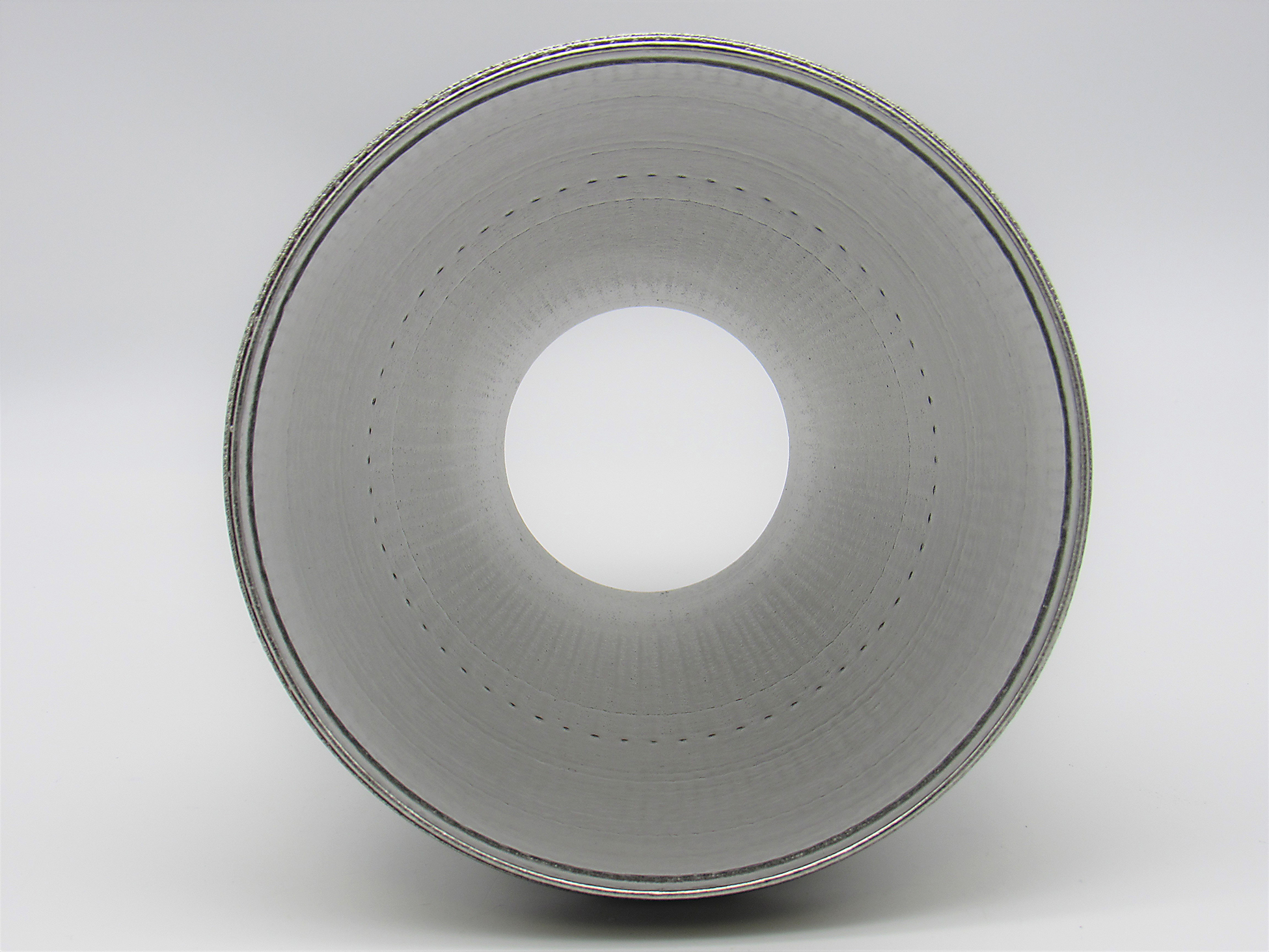
Metal powder production
Lastly, the tour visited three AM suppliers not directly related to primarily part-forming operations: Hoganas, Questek Innovations, and REM Surface Engineering — all members of the 3DPC. Hoganas is a well-known leader in metal powder production. They shared information with the 3DPC about their steel materials with potential applicability to gear applications such as 16MnCr5. Questek Innovations is a leading materials design company that uses an integrated computational materials engineering (ICME) approach to designing alloys for specific applications in the aerospace and energy industries (to name a few). Questek shared information about projects they are leading to qualify some of their Ferrium materials for L-PBF and binder jet gear applications. Lastly, REM Surface Engineering is a leading surface finishing supplier whose ISF® Process is widely used in precision gear applications and Extreme ISF® Process is a leading performance-enhancing AM surface polishing solution for rocket engine, aerospace, medical, and semi-conductor fabrication applications. REM shared updates regarding their new alloy processing and process scaling developments as well as current work on government awards including AM support structure removal and internal channel finishing. These three suppliers are currently and are expected to continue supporting and enabling the application of AM to gear applications in the near future.
Summary
In conclusion, the 3DPC observed significant advancements and maturation of the metal AM industry. While it is certainly an industry still in need of industrialization relative to process control, repeatability, and costs, there are two defined avenues (large format gear repair/replacement and low criticality/small-sized gear production) whereby AM is ready to support gear manufacturing today.













